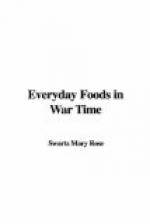Is it not strange that out of half a dozen different grains cultivated for human consumption, the demand should concentrate upon wheat? One might almost say that the progress of civilization is marked by raised bread. And wheat has, beyond all other grains, the unique properties that make possible a light, porous yet somewhat tenacious loaf. We like the taste of it, mild but sweet; the feel of it, soft yet firm; the comfort of it, almost perfect digestion of every particle. We have been brought up on it and it is a hardship to change our food habits. It takes courage and resolution. It takes visions of our soldiers crossing the seas to defend us from the greedy eye of militarism and thereby deprived of so many things which we still enjoy. Shall we hold back from them the “staff of life” which they need so much more than we?
Can we live without wheat? Certainly, and live well. We must recognize the scientific fact that no one food (with the exception of milk) is indispensable. There are four letters in the food alphabet: A, fuel for the body machine; B, protein for the upkeep of the machinery; C, mineral salts, partly for upkeep and partly for lubrication—to make all parts work smoothly together; D, vitamines, subtle and elusive substances upon whose presence depends the successful use by the body of all the others. These four letters, rightly combined, spell health. They are variously distributed in food materials. Sometimes all are found in one food (milk for example), sometimes only one (as in sugar), sometimes two or three. The amounts also vary in the different foods. To build up a complete diet we have to know how many of these items are present in a given food and also how much of each is there.
Now, cereals are much alike in what they contribute to the diet. In comparing them we are apt to emphasize their differences, much as we do in comparing two men. One man may be a little taller, a little heavier, have a different tilt to his nose, but any two men are more alike than a man and a dog. So corn has a little less protein than wheat and considerably less lime, yet corn and wheat are, nutritionally, more alike than either is like sugar.
None of the cereals will make a complete diet by itself. If we take white bread as the foundation, we must add to it something containing lime, such as milk or cheese; something containing iron, such as spinach, egg yolk, meat, or other iron-rich food; something containing vitamines, such as greens or other vitamine-rich food; something to reenforce the proteins, as milk, eggs, meat, or nuts. It is not possible to make a perfect diet with only one other kind of food besides white bread. It can be done with three: bread, milk, and spinach, for example.




